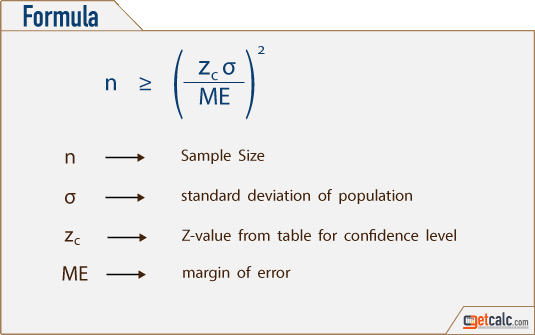Sample Size Calculator
getcalc.com's Sample Size calculator is an online statistics & probability tool to estimate the correct number of samples from the population or right portion of population to be included in the statistical survey or experiments to draw the effective conclusion about the population, by using standard deviation or proportion method. This calculator is featured to generate the work with steps which may help beginners to learn or understand how the sample size is being calculated from the known or unknown population under experiment.
Input Parameters
Users may supply the values for the below input parameters to find the effective sample size to be statistically significant by using this sample size calculator.
Confidence level :
It's a measure of probability that the confidence interval have the unknown parameter of population, generally represented by 1 - α. 0.01, 0.05, 0.10 & 0.5 represents 99%, 95%, 90% and 50% confidence levels respectively. It's often associated with confidence interval.
Margin of Error :
It's a measure of effectiveness of statistical survey or experiments. Higher or lower score of MOE generally represents statistically lesser or higher confidence respectively in experimented results.
by using standard deviation method
Standard Deviation :
It's a measure of deviation of whole elements from the mean of sample or population. It usually represented by σ for population data & s for sample data. It tells the overall uncertainty behaviour of the group of elements.
by using proportion method
Proportion :
It's a portion of population used in the statistical experiments to characterize the population parameters.
Need of Sample Size & Formula
The number of observations or portion of a known or infinite population is known as Sample Size. A probability & statistics tool used to estimate the right number of samples from the population to be included in the statistical survey or experiments to draw the effective conclusion about the known or infine population is known as sample size calculator. The sample size of a population should be fair or large enough to draw a better estimate which posses enough statistical power in surveys or experiments. Estimating the characteristics of population from sample is known as statistics. The estimation will have more confidence when the experiment includes more samples and vice versa. The mean of larger sample size x̄ is almost equal to expected parameter μ. Margin of error is often associated with sample size calculation to estimate the tolerance of interest of statistic included in the experiments.
The need for samples in statistics
Sampling plays an important role in probability & statistics for the following reasons. The finite subset of population is required because
1. The population is infinitly large or wider. Molecules of chemical compounds or materials, weather data, tissues of animals, etc. are some of the examples where the population is infinitely large.
2. The analysis report is required in short time.
3. To control the spent for collecting the data.
Formulas
Users may found the effective sample size by using population standard deviation or by population proportion. The below formulas are the mathematical representation for both population standard deviation and portion of (proportion) population methods which may help users to know what are all the input parameters are being used in such calculations to find the sample size which produces statistically significant results.


Solved Example Problems with Steps
The below are some of the solved examples with solutions to help users to know how to estimate reliable sample size by using stanadrd deviation or proportion method. Users can use this sample size calculator to verify the results with different input parameters.
- What is the sample size required for experiment results to be statistically significant at 95% confidence level for the population with 2.65 standard deviation and 5% margin of error.
- For 99% confidence level of results, what is the sample size that produce statistically significant results for an infinite population has 6 standard deviation and margin of error 7%.
- At 90% confidence level, what is the sample size that produce statistically significant results for an infinite population has 0.25 proportion and margin of error 9%.

